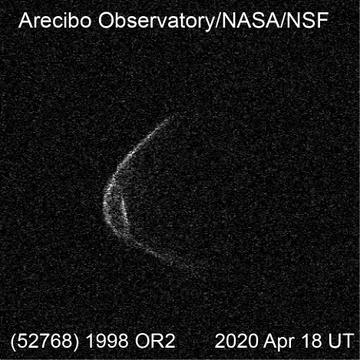You are using an out of date browser. It may not display this or other websites correctly.
You should upgrade or use an alternative browser.
You should upgrade or use an alternative browser.
Ancient Comet ‘Atlas’ is Back! Plus Giant Asteroid
- Thread starter NewEngland Seeker
- Start date
-
- Tags
- april drop dead comet
anka
The Living Force
There is another object coming from south, not visible in the Norther hemisphere yet until crossing the ecliptic around May 7/8. And it appears just as interesting as ATLAS C4/2019. It's name is Comet Swan (C/2020 F8). Its orbit can be seen here.
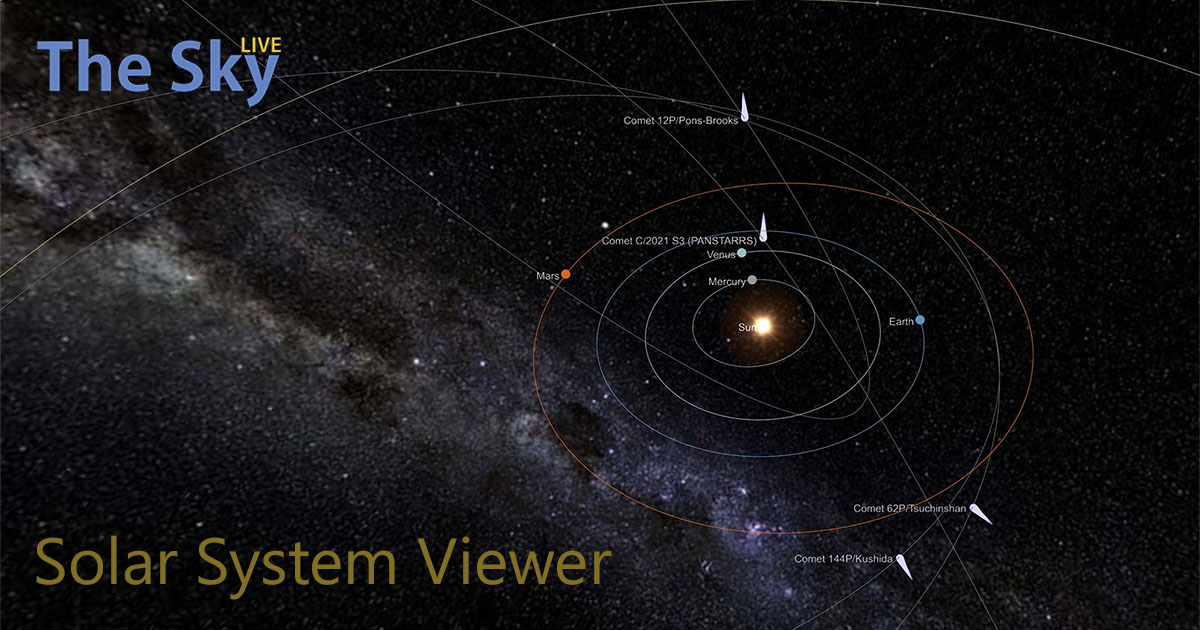
 theskylive.com
theskylive.com
Closest approach: March 13th (0.56 AU or 85,065,197 km)
Predicted naked eye visibility: May 21st (magnitude 6, just about visible, but remember it is just a projection which rarely materializes)
Current magnitude: 11.26 according to SkyLive, although 8 according to the article below
Telescopes down under are already taking impressive pics:

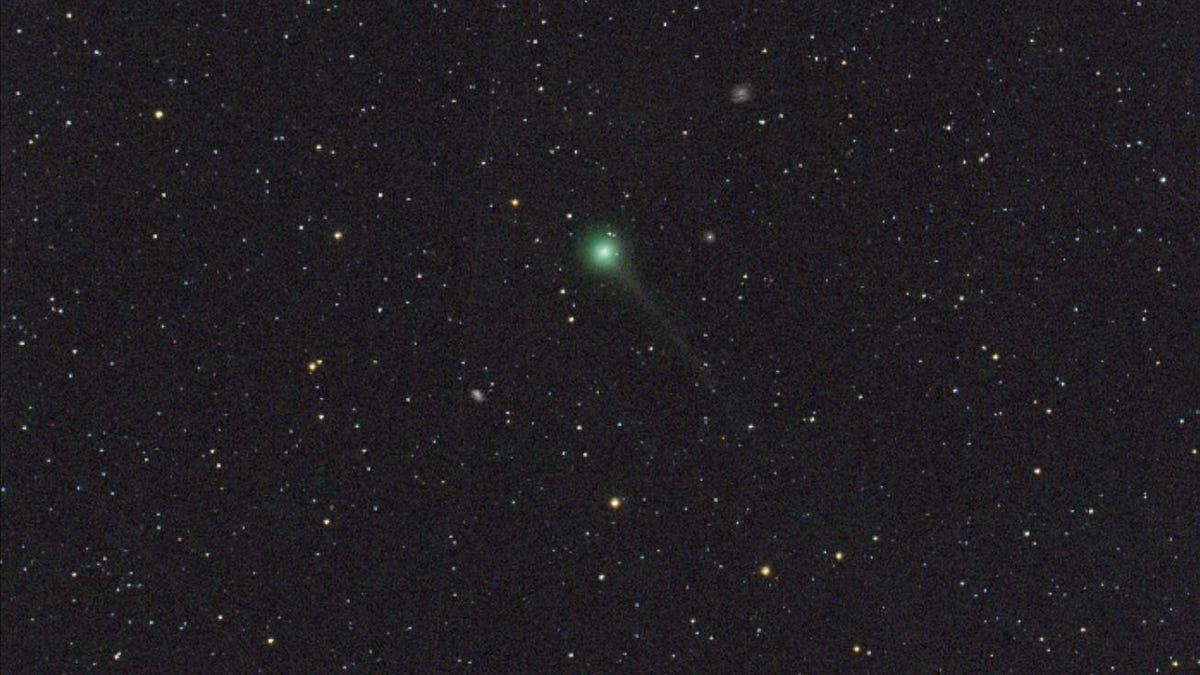
 www.cnet.com
www.cnet.com
So we have two bodies of interest at around same time. ATLAS's perihelium happens first week of June, SWAN's the last week of May. If SWAN becomes visible, it should be even more of a show because her orbit during May is from the Earth point of view almost 90 degrees to the Sun, so less daylight in the way.
This image is from the simulator and shows SWAN at the time of crossing the ecliptical plane from the bottom up around May 7/8. If she had a long tail at that time (something like 1.2 x distance of Earth-Venus orbits, which is on average 40,000,000 kms so the tail would have to be almost 50 million kms long which is big but not unrealistic), the tail would sweep our orbit and we would go through that area around June 13:

There is another interesting factor which I noticed while playing with the 3D orbit simulator. It may not play an important role in the comet thing but feels somehow connected to the tensions on human-cosmic level. Between mid of June and mid of July, the first six planets of our system, Mercury, Venus, Earth, Mars, Jupiter, Saturn, together with Pluto will be in one narrow strip. Not exactly in conjunction, but close together enough to have an extra force. I could not identify the bright star displayed in the simulator which appears to be very well aligned with the bunch of planets but if it is not Sirius then it must be among five brightest ones.
The whole setup appears rather unusual. Neptun and Uran are about up to 90 degrees off the rest but then there is nothing on the other side of the Solar system in radius of 270 degrees to keep gravitational balance, maybe just the asteroid belt. Like a pendullum in full swing. Looks really intriguing:
June 15:

July 15:

Edit: grammar

Comet SWAN (C/2020 F8) Orbit | 3D Solar System Viewer | TheSkyLive
Visualization of the orbit of Comet SWAN (C/2020 F8) in an interactive 3D Solar System viewer and simulator.
Closest approach: March 13th (0.56 AU or 85,065,197 km)
Predicted naked eye visibility: May 21st (magnitude 6, just about visible, but remember it is just a projection which rarely materializes)
Current magnitude: 11.26 according to SkyLive, although 8 according to the article below
Telescopes down under are already taking impressive pics:

Comet Atlas is crumbling, but another is already brightening skywatchers' nights
One big dirty ice chunk is falling apart, but Comet Swan looks poised to take its place.
At the moment a promising comet is fading, a newly discovered cosmic snowball has been spotted in an outburst phase, giving us a bright new distraction from dark days here on planet Earth.
When it it went through a period of rapid brightening in March, Comet Atlas (C/2019 Y4) looked as though it might put on a spectacle in the night sky unlike anything we've seen in years. But comets are famously erratic and unpredictable, and within weeks it became clear that Atlas was breaking up as it flew toward the overwhelming heat and radiation of the sun.
Seemingly on cue, a new bright comet has emerged to delight skywatchers.
Comet Swan (C/2020 F8) is named after the Solar Wind Anisotropies device aboard NASA's Solar and Heliospheric Observatory that was used to discover it. Astronomer Ernesto Guido in Italy was then able to confirm the existence of the new comet, which is currently an 8th magnitude brightness object. That means it's not quite visible to the naked eye, but could be viewed with binoculars or small telescopes.
"It's extremely likely that the comet is in 'outburst' mode," Karl Battams of the Naval Research Lab and NASA's Sungrazing Comets Project told Spaceweather.com.
If it continues to brighten, Swan could become visible to the naked eye in May. But Battams -- who successfully predicted the disappointment of Comet Atlas -- is skeptical once again.
"I doubt the comet will maintain its current impressive appearance, and will quite possibly fade away soon," Battams said, "but we've only been viewing it for a couple of days, so no one knows."
More observations are needed to have a better idea of whether comet Swan will soon be worth staying up late for. I'll be sure to keep you posted as to whether it shines or fizzles.
So we have two bodies of interest at around same time. ATLAS's perihelium happens first week of June, SWAN's the last week of May. If SWAN becomes visible, it should be even more of a show because her orbit during May is from the Earth point of view almost 90 degrees to the Sun, so less daylight in the way.
This image is from the simulator and shows SWAN at the time of crossing the ecliptical plane from the bottom up around May 7/8. If she had a long tail at that time (something like 1.2 x distance of Earth-Venus orbits, which is on average 40,000,000 kms so the tail would have to be almost 50 million kms long which is big but not unrealistic), the tail would sweep our orbit and we would go through that area around June 13:
There is another interesting factor which I noticed while playing with the 3D orbit simulator. It may not play an important role in the comet thing but feels somehow connected to the tensions on human-cosmic level. Between mid of June and mid of July, the first six planets of our system, Mercury, Venus, Earth, Mars, Jupiter, Saturn, together with Pluto will be in one narrow strip. Not exactly in conjunction, but close together enough to have an extra force. I could not identify the bright star displayed in the simulator which appears to be very well aligned with the bunch of planets but if it is not Sirius then it must be among five brightest ones.
The whole setup appears rather unusual. Neptun and Uran are about up to 90 degrees off the rest but then there is nothing on the other side of the Solar system in radius of 270 degrees to keep gravitational balance, maybe just the asteroid belt. Like a pendullum in full swing. Looks really intriguing:
June 15:
July 15:
Edit: grammar
Michael B-C
The Living Force
Michael hope it's ok to add this.Some oberserved points and talking about ten fragments now.
As long as it's not noise, you should post whatever you think is right Talas; you don't need anyone's permission here! However if you haven't yet done so, you might want to take a look into the electrical nature of comets. This guy in the video - no doubt well meaning - is just parroting the establishment line that comets are merely dirty snowballs and it's all about melting ice as a result of heat from the sun. Same here in the article posted above by anka:
At the moment a promising comet is fading, a newly discovered cosmic snowball has been spotted in an outburst phase, giving us a bright new distraction from dark days here on planet Earth.
This ridiculous notion is demonstrably false - as every NASA comet probe has discovered to their absolute shock and dismay. The influence of an electrically charged body like a comet as it travels through the earth's vast magnetosphere is what's really at stake.
Have you read the following? If not I would huge recommend you get yourself a copy - it will electrocute your mind!
Earth Changes and the Human Cosmic Connection: The Secret History of the World - Book 3
anka
The Living Force
Don't blame Talas for posting it - it was meThis ridiculous notion is demonstrably false - as every NASA comet probe has discovered to their absolute shock and dismay. The influence of an electrically charged body like a comet as it travels through the earth's vast magnetosphere is what's really at stake.
...
Have you read the following? If not I would huge recommend you get yourself a copy - it will electrocute your mind!

And I sure understand what you mean - the article I reposted was chosen because it mentions the new comet and gives a few details about it. I never claimed it is a dirty snowball and suppose no one here would acuse me of that
 ... although, when I think of it, it could be anything these days, even flying amoeba. I am ready to discover anything
... although, when I think of it, it could be anything these days, even flying amoeba. I am ready to discover anything 
Talas
Jedi Master
Yes I understand the electrical nature of comets and all body's and nice to see you putting there true nature to task and as for the book I have indeed read it and highly recommend it hopefully seeing this people can see your explanation and you won't get more crazy vid uploads from YouTube there's s fair few and that was just an example expect many more the earth is going to be destroyed by comet Atlas or its fragments to come.Best.As long as it's not noise, you should post whatever you think is right Talas; you don't need anyone's permission here! However if you haven't yet done so, you might want to take a look into the electrical nature of comets. This guy in the video - no doubt well meaning - is just parroting the establishment line that comets are merely dirty snowballs and it's all about melting ice as a result of heat from the sun. Same here in the article posted above by anka:
This ridiculous notion is demonstrably false - as every NASA comet probe has discovered to their absolute shock and dismay. The influence of an electrically charged body like a comet as it travels through the earth's vast magnetosphere is what's really at stake.
View attachment 35466
Have you read the following? If not I would huge recommend you get yourself a copy - it will electrocute your mind!
Earth Changes and the Human Cosmic Connection: The Secret History of the World - Book 3
View attachment 35465
Ocean
The Living Force
Did Comet Atlas break up?
Did Comet Atlas C/2019 Y4 Shatter? We Share A Rare Close-Up - Comet C/2020 F8 SWAN To The Rescue!
Nasa shares rare close-up of comet breaking up – and you can see it in the night sky right now

 www.thesun.co.uk
www.thesun.co.uk
Did Comet Atlas C/2019 Y4 Shatter? We Share A Rare Close-Up - Comet C/2020 F8 SWAN To The Rescue!
Nasa shares rare close-up of comet breaking up – and you can see it in the night sky right now

Nasa shares rare close-up of comet breaking up – and you can see it in the night sky right now
NASA has chosen a striking image of Comet ATLAS C2019/Y4 as its Astronomy Picture of the Day. If you’re impressed by the snap below then you’re in luck because right now you may also be…
WIN 52
The Living Force
Did Comet Atlas break up?
Did Comet Atlas C/2019 Y4 Shatter? We Share A Rare Close-Up - Comet C/2020 F8 SWAN To The Rescue!
Nasa shares rare close-up of comet breaking up – and you can see it in the night sky right now

Nasa shares rare close-up of comet breaking up – and you can see it in the night sky right now
NASA has chosen a striking image of Comet ATLAS C2019/Y4 as its Astronomy Picture of the Day. If you’re impressed by the snap below then you’re in luck because right now you may also be…www.thesun.co.uk
And we all know that NASA always tells the truth!
So, watch for the dirty snowball that we may never see!
SOTTREADER
The Living Force
Did you guys know there was another Atlas (Y1)... I didn't... #mindblown! 
Y1 has already had its perihelion - back in March. Apparently it's visible with binoculars at magnitude 8 currently.

 www.universetoday.com
www.universetoday.com
Anyways, regarding the atlas in question (Y4), apparently it's recently started getting brighter again. It's now magnitude 7.5. The analysis I watched stated this wasn't necessarily cause for excitement.
 www.cobs.si
www.cobs.si
Y1 has already had its perihelion - back in March. Apparently it's visible with binoculars at magnitude 8 currently.

Following Comet Y1 ATLAS: the 'Lost Comet' of Spring
Got clear skies? If you're like us, you've been putting the recent pandemic-induced exile to productive use, and got out under the nighttime sky. And though 2020 has yet to offer up a good bright 'Comet of the Century' to keep us entertained, there have been a steady stream of good binocular...
Anyways, regarding the atlas in question (Y4), apparently it's recently started getting brighter again. It's now magnitude 7.5. The analysis I watched stated this wasn't necessarily cause for excitement.
COBS - Comet OBServation database
karo
Jedi
Did you guys know there was another Atlas (Y1)... I didn't... #mindblown!
Asteroid Terrestrial-impact Last Alert System
Regarding youtube video from your post - I've checked trajectory of Comet Y4 Atlas in relation to Mercury and it doesn't seem like they are going to meet in way described there.Did Comet Atlas break up?
Did Comet Atlas C/2019 Y4 Shatter? We Share A Rare Close-Up - Comet C/2020 F8 SWAN To The Rescue!
Nasa shares rare close-up of comet breaking up – and you can see it in the night sky right now

Nasa shares rare close-up of comet breaking up – and you can see it in the night sky right now
NASA has chosen a striking image of Comet ATLAS C2019/Y4 as its Astronomy Picture of the Day. If you’re impressed by the snap below then you’re in luck because right now you may also be…www.thesun.co.uk
Talas
Jedi Master
11 fragments in that first picture ..The first images from the HST are starting to be published:
View attachment 35635
View attachment 35636
Corona 1984 craziness is going cosmic.
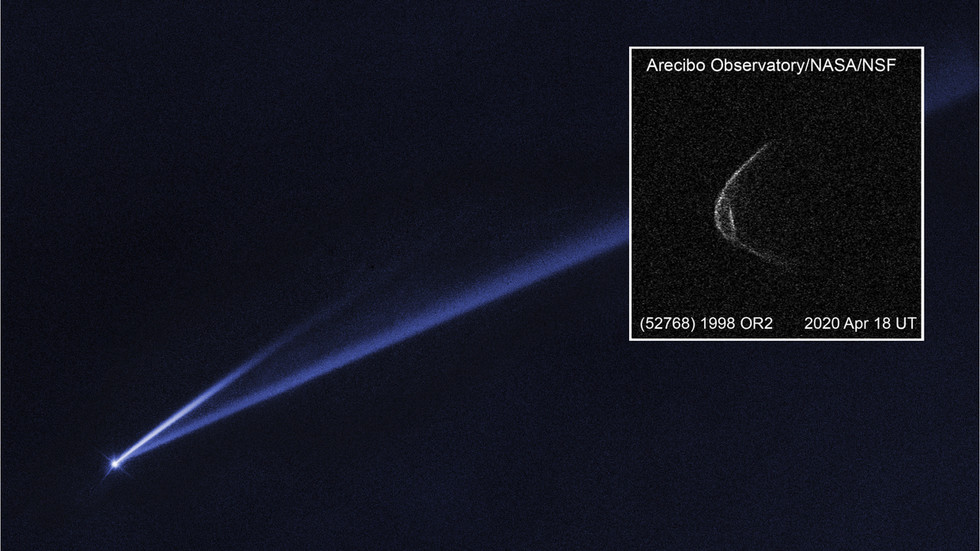
 www.rt.com
www.rt.com
Astronomers snap fresh IMAGES of enormous ‘face mask wearing’ asteroid that’s heading our way
23 Apr, 2020 12:31 / Updated 1 hour ago
Get short URL
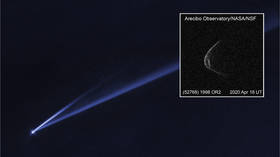
1998 OR2 (inset) will have its closest flyby of Earth in at least 100 years later this month. © Arecibo Observatory/NASA/NSF; Asteroid file photo: © AP

A mountain-sized asteroid that’s currently zooming in Earth’s direction has been photographed in unprecedented quality by astronomers who quipped that it appears to be wearing a face mask.
The gigantic space rock – snappily dubbed 1998 OR2 – is set to have its closest flyby of our planet in at least a century when it safely whizzes past Earth at a distance of 6.3 million kilometers (around four million miles) on April 29.
Two teams of space-watchers have already caught glimpses of the asteroid as its presence grows brighter in the night sky, hurtling towards Earth at a speed of around 31,320kph (19,461mph).

1998 OR2 as photographed in recent days. © Arecibo Observatory/NASA/NSF
Both the Virtual Telescope Project in Rome and the Arecibo Observatory in Chile released their fresh snaps. The Chilean team joked that the space rock appeared to be keeping in tune with trends here on Earth by wearing a face mask.
“#TeamRadar and the @NAICobservatory staff are taking the proper safety measures as we continue observations. This week we have been observing near-Earth asteroid 1998 OR2, which looks like it’s wearing a mask!” it tweeted.
152 people are talking about this
The enormous astronomical object measures more than 1.5km across and is classified as a “potentially hazardous” asteroid because all large space rocks that come within 7,480,000km (4,650,000 miles) of Earth are given the classification.
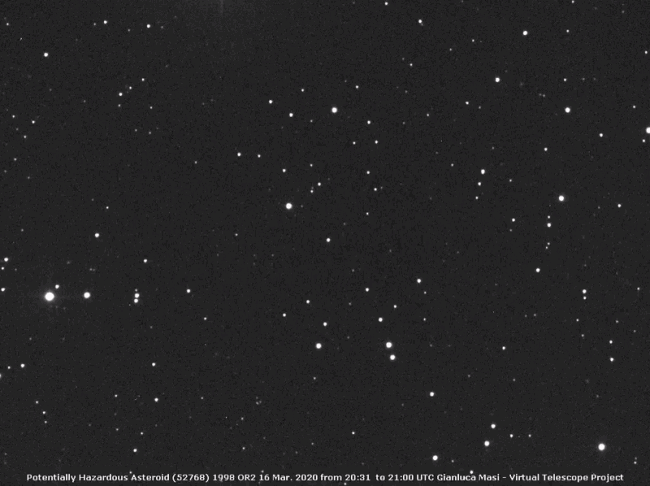
Virtual Telescope Project animation shows the movement of 1998 OR2 in the night sky. © Gianluca Masi/The Virtual Telescope Project
The flyby offers astronomers a fantastic chance to learn more about the composition of 1998 OR2 as it passes. It will also allow them to take measurements of the planetoid in order to refine how it sizes asteroids.
Tracking giant asteroids also helps scientists to concoct measures for defending Earth against objects that could potentially pose a real risk to our planet.

Astronomers snap fresh IMAGES of enormous ‘face mask wearing’ asteroid that’s heading our way
A mountain-sized asteroid that’s currently zooming in Earth’s direction has been photographed in unprecedented quality by astronomers who quipped that it appears to be wearing a face mask.
Astronomers snap fresh IMAGES of enormous ‘face mask wearing’ asteroid that’s heading our way
23 Apr, 2020 12:31 / Updated 1 hour ago
Get short URL

1998 OR2 (inset) will have its closest flyby of Earth in at least 100 years later this month. © Arecibo Observatory/NASA/NSF; Asteroid file photo: © AP
- 22
A mountain-sized asteroid that’s currently zooming in Earth’s direction has been photographed in unprecedented quality by astronomers who quipped that it appears to be wearing a face mask.
The gigantic space rock – snappily dubbed 1998 OR2 – is set to have its closest flyby of our planet in at least a century when it safely whizzes past Earth at a distance of 6.3 million kilometers (around four million miles) on April 29.
Two teams of space-watchers have already caught glimpses of the asteroid as its presence grows brighter in the night sky, hurtling towards Earth at a speed of around 31,320kph (19,461mph).

1998 OR2 as photographed in recent days. © Arecibo Observatory/NASA/NSF
Both the Virtual Telescope Project in Rome and the Arecibo Observatory in Chile released their fresh snaps. The Chilean team joked that the space rock appeared to be keeping in tune with trends here on Earth by wearing a face mask.
“#TeamRadar and the @NAICobservatory staff are taking the proper safety measures as we continue observations. This week we have been observing near-Earth asteroid 1998 OR2, which looks like it’s wearing a mask!” it tweeted.
Arecibo Radar@AreciboRadar
https://twitter.com/AreciboRadar/status/1251638650682650630
#TeamRadar and the @NAICobservatory staff are taking the proper safety measures as we continue observations. This week we have been observing near-Earth asteroid 1998 OR2, which looks like it's wearing a mask! It's at least 1.5 km across and is passing 16 lunar distances away!
325
6:28 PM - Apr 18, 2020
Twitter Ads info and privacy
152 people are talking about this
The enormous astronomical object measures more than 1.5km across and is classified as a “potentially hazardous” asteroid because all large space rocks that come within 7,480,000km (4,650,000 miles) of Earth are given the classification.

Virtual Telescope Project animation shows the movement of 1998 OR2 in the night sky. © Gianluca Masi/The Virtual Telescope Project
The flyby offers astronomers a fantastic chance to learn more about the composition of 1998 OR2 as it passes. It will also allow them to take measurements of the planetoid in order to refine how it sizes asteroids.
Tracking giant asteroids also helps scientists to concoct measures for defending Earth against objects that could potentially pose a real risk to our planet.
SOTTREADER
The Living Force
[Deleted] think that was the wrong asteroid! Please delete post.
Last edited:


